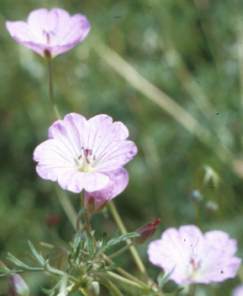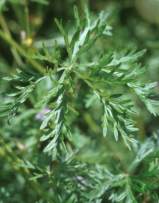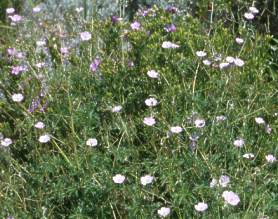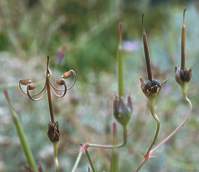Geranium multisectum
Geranium multisectum N.E.Br.
Family: Geraniaceae
Common names: crane's bill
Introduction
Like pelargoniums, this is a geranium which makes an interesting garden plant.
Description
Description

Geranium multisectum is a lovely, soft herbaceous perennial with masses of delicate mauve flowers in summer and attractive soft foliage throughout the year. Cuttings of Geranium multisectum were collected in the Drakensberg a few years ago and very successfully propagated and grown at Kirstenbosch.

Not many indigenous geraniums, other than Geranium incanum, are grown in gardens. At first glance these two geraniums appear much alike, but they are really quite different in their growth habit, leaf shape and colour, and flowering time. Geranium incanum has a more low-growing mounding habit, greener, more finely divided foliage and its main flowering season is spring. Geranium multisectum has a looser habit and it grows a little taller, its leaves are not as finely divided, are presented in a flattish star-like shape and the overall effect is much greyer, and its main flowering season is during summer.

Geranium multisectum is a herbaceous perennial that forms loose mounds about 30 cm high. As it gets older the lower stems get thicker and woody, but most of the branches are soft green and covered with tiny white hairs. The leaves are finely divided, blue green above and almost white-grey below. The tips of the leaves and parts of the stems are brushed with red. Throughout the summer, flower buds appear in pairs at the tip of long slender stalks, which divide many times and stand tall and proud above the foliage. The plump buds unfold into single, simple cup-shaped flowers with five soft mauve, almost transparent petals that are marked with dark mauve veins. In the centre of the flower, ten stamens surround the bright red stigma and nectar glands that are frequently visited by bees.

The individual flowers do not last for long and as soon as the petals drop, the seeds start to develop. This process may not be as colourful as the flowers, but is fascinating to watch. From the centre the style (elongated projection from the ovary which bears the stigma) or beak as it is commonly known, grows longer until it stands upright like a candle with a bright red tip. The ripe seeds are flung far and wide by an explosive mechanism that is triggered once the seed is ripe and dry. It is fun to see this happen by pressing at the base of the dry beak and watch the tails arch and disperse the seed.
Distribution and habitat
Distribution description
In the wild it is found widespread in open marshy places throughout the summer rainfall areas of southern Africa from the Eastern Cape to KwaZulu-Natal, Lesotho, the eastern Free State and the Mpumalanga highveld.
Derivation of name and historical aspects
History
The name Geranium is derived from an ancient Greek word geranos, a crane, referring to the similarity of the long beaked fruit (seed capsule) to the bill of the crane. There are 300 species of Geranium found throughout the montane tropics and temperate regions of the world, with 33 species in southern Africa. Many people find the difference between Geranium and Pelargonium confusing for both belong to the family Geraniaceae, and pelargoniums are often commonly called geraniums. The difference is very easy to see: it is all in the shape of the flower. Geraniums have a very simple circular shaped flower with five equal sized petals while the pelargoniums have huge variation in their irregular shaped flowers that usually have two petals pointing up and three petals pointing down.
Growing Geranium multisectum
Grow
Geranium multisectum is easy to grow from seed or cuttings. At Kirstenbosch we mostly propagate them from cuttings which can be made throughout the year. Seed can be sown in spring or summer. Geraniums propagated from seed tend to produce more vigorous plants.
Geranium multisectum can be used in many places in the garden from pots, to rockeries, to herbaceous borders as long as the plants receive full sun, well-composted soil and regular watering throughout the year. For a herbaceous plant this geranium can get quite old, and looks neat without much pruning for many years. The fine blue-green leaves contrast beautifully with lush green foliage such as that of the sea-rose, Orphium frutescens, and Agapanthus species or with other grey leaves like those of the succulent plakkie, Cotyledon orbiculata and the neatly shaped white everlasting, Helipterum argyropsis.
Credits
Liesl van der Walt
Kirstenbosch National Botanical Garden
December 2001
Plant Attributes:
Plant Type: Ground Cover, Perennial
SA Distribution: Eastern Cape, Free State, KwaZulu-Natal, Mpumalanga
Soil type: Sandy, Loam
Flowering season: Early Summer, Late Summer, Sporadic/All year
PH: Acid, Neutral
Flower colour: Mauve/Lilac
Aspect: Full Sun
Gardening skill: Easy
Special Features:
Horticultural zones









Rate this article
Article well written and informative
Rate this plant
Is this an interesting plant?
Login to add your Comment
Back to topNot registered yet? Click here to register.